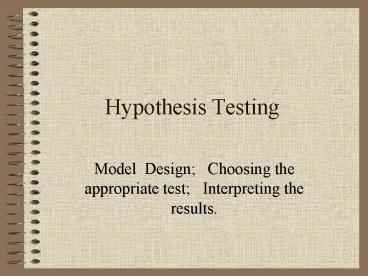Hypothesis Testing PowerPoint PPT Presentation
1 / 16
Title: Hypothesis Testing
1
Hypothesis Testing
- Model Design Choosing the appropriate test
Interpreting the results.
2
Examples
- Does Air Conditioning affect monthly rent?
- Does being at the beach increase the apartments
rent by more than 200? - Do amenities affect rent?
- Does a production function exhibit constant
returns to scale?
3
Hypothesis Testing Tests Involving A Single
Parameter
- Set Up the Null and Alternative Hypotheses
- H0 b0
- HA b?0
- Choose a Level of Significance and Critical
t-value - Run the regression and obtain estimated t.
- Apply the decision rule by comparing the
calculated t and the critical t-value in order to
reject or accept the null hypothesis.
4
Test Statistic
5
Example -- Air Conditioning
- LARENT a1a2SQFTa3ACe
- Null Hypothesis?
- H0 a40
- HA a4 gt0
- Appropriate Test?
- Test Involving a Single Parameter
- Two-sided Test
6
Limitations of Significance Tests
- The t-test does not test theoretical validity
- A statistically insignificant result need not
mean that a regressor has little or no effect on
the dependent variable. - The t-test does not test importance.
- The t-test is not intended for tests of the
entire population.
7
Limitations of Significance Tests
- The t-test does not test theoretical validity
- P 10.9 - 3.2C 0.39C2
- (-13.9) (19.5)
- R2 .982, n21
- where P is consumer price index in Great Britain
and C is cumulative rainfall.
8
Limitations of Significance Tests
- A statistically insignificant result need not
mean that a regressor has little or no effect on
the dependent variable. - This is an example of Type II Error
- This problem is likely to arise where
- (i) The sample is too small.
- (ii) There is too little variance in the
observed values of the explanatory variable. - (iii) There is a high variance in the effects of
X on the dependent variable.
9
Limitations of Significance Tests
- The t-statistic does not measure importance.
- How Important Is the SAT Score in Determining
Class Rank? - The test statistic t5.929/0.11850.25
- A 100 point increase in SAT score improves class
rank by 6 percentile points
10
Does Being Near Beach Increase Rent by More than
200?
- H0 bgt200HA b0
- Type I error -reject H0 when it is true and lose
moneyType II error - fail to reject H0 when it
is false and lose money - One Sided Test
11
Joint Tests on Several Regression Coefficients
- Set Up the Null and Alternative Hypotheses
- Choose level of significance and critical F value
- Run two regressions and obtain estimated F-value
- Restricted model assumes bs0
- Unrestricted model assumes bs ? 0
- Apply the decision rule
12
F Statistic
13
Do Amenities Matter?
- H0 bac0 bdw0 bpool0 bgym0 bfp0
balarm0HA bac?0 or bdw?0 or bpool?0 or bgym?0
or bfp?0 or balarm?0
14
Using F-Test
- Estimate model without ac,dw,fp, pool, gym, alarm
- Use residual (error) sum of squares from this
model and residual (error) sum of squares from
original model to calculate F-statistic. - Degrees of freedom, numeratorq6
- Degrees of freedom,denominator153-10143
15
Testing a Linear Combination of Coefficients
- Does A Cobb Douglas production function exhibit
constant returns to scale? - QALaKb
- log Q g a ln L b ln K where gln A
- Set Up Null and Alternative Hypothesis
- H0 ab1
- HA ab?1 (or we may be interested in one tail
test of economies of scale, abgt1) - Choose level of significance and critical F
16
Testing a Linear Combination, continued
- Using the restriction, solve for one of three
coefficients in terms of the others and
substitute that in the unrestricted model to
obtain the restricted model. - Unrestricted model ln Q galn L b ln K
- Restricted model ln Q-ln K galn L - ln K
- Calculate the F-Statistic.

